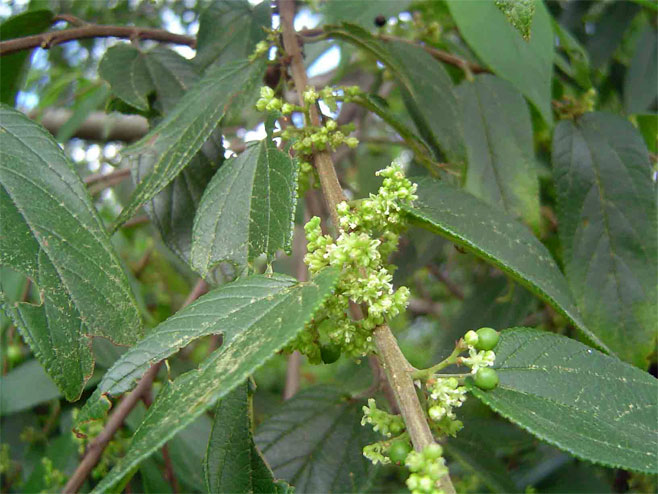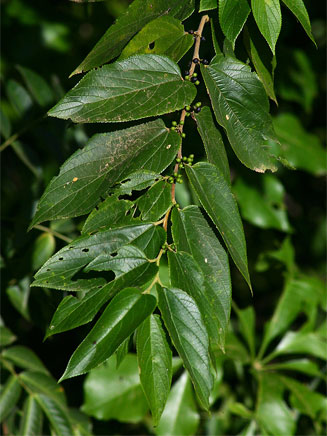Trema orientalis (Pigeonwood)
Hophout [Afrikaans]; umVumvu, umVangazi,
umBengele, uPhakane [Xhosa]; umSekeseke, umBhangabhanga [Zulu];
umBalalaqane [Swazi]; mpukupuku [Tsonga]; modutu [North Sotho];
makuru-kuru [Venda]
Life
> eukaryotes >
Archaeoplastida >
Chloroplastida
>
Charophyta > Streptophytina > Plantae (land plants)
> Tracheophyta (vascular plants) > Euphyllophyta > Lignophyta (woody plants)
> Spermatophyta (seed plants) > Angiospermae (flowering
plants) > Eudicotyledons > Core Eudicots > Rosids >
Eurosid I > Order: Rosales
> Family: Cannabaceae
 |
|
Trema orientalis, Leopard Rock Game
Reserve, Vumba, Zimbabwe. [photo Bart Wursten ©, Flora of Zimbabwe] |
 |
 |
|
Trema orientalis, Rusitu Forest, Zimbabwe. [photo
Bart Wursten ©, Flora of Zimbabwe] |
Trema orientalis, Leopard Rock Game
Reserve, Vumba, Zimbabwe. [photo Bart Wursten ©, Flora of Zimbabwe] |
Identification
A shrub or small tree, growing to a height of
13 m. Trema orientalis is most easily confused with Celtis
africana
because they both have hairy, serrated leaves that are conspicuously
3-veined from the base and asymmetric at the base. However, they can
be easily distinguished by the fact that the serrations on the leaf
are only on the upper half of the leaf in Celtis africana
whereas they occur along the entire margin of the leaf in Trema
orientalis. See comparison of
native Celtis and Trema species.
Distribution and habitat
Native to Africa south of the Sahara,
Madagascar, Mascarene Is and tropical Asia. Within southern Africa,
it is native to the Eastern Cape, KwaZulu-Natal, Limpopo,
Mpumalanga, Northwest Province, northwestern Namibia, Swazilind,
Zimbabwe and Mozambique. It is absent from the drier parts of the
region and from the Western Cape.
Ecological interactions
- Fruit are eaten by:
- birds
- mammals
-
Pteropodidae (fruit bats) - recorded by Palmer &
Pitman (1972)
- Leaves are eaten by:
- Trees act as nesting sites for:
Uses
- Young leaves are eaten like spinach by people in
KwaZulu-Natal.
- The roots are used in combination with other plants as an
emetic.
Links
References
- Palgrave, K.C. and Palgrave, M.C. 2002. Trees of Southern Africa. 3rd
Edition. Struik Publishers, Cape Town.
- Palmer, E. and Pitman, N. 1972. Trees of Southern Africa covering all
known indigenous species in the Republic of South Africa, South-West Africa,
Botswana, Lesotho and Swaziland. Volume 1. A.A. Balkema, Cape
Town.
- van Wyk, B. and van Wyk, P. 1997. Field Guide to Trees of Southern
Africa. Struik Publishers, Cape Town.
Text by Hamish Robertson |
